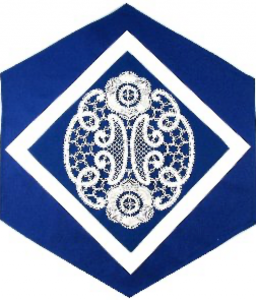Belgium

The Block
Lace-making has long been a part of Belgian history, from the fifteenth century when Charles the Fifth decreed that it was to be taught in schools and convents, to the present day where the art is still passed down from generation to generation. It is fitting, therefore, that the Belgium block features an example of this world-renowned fibre art. The block-maker, Hélène Plouffe, used fine pearl cotton thread to create an original and complex pattern of highly prized bobbin lace. This technique is a form of off-loom weaving worked from a ‘pricking’ (prepared pattern) that is fastened with pins to a rock-hard, firmly-stuffed pillow or cushion. Each thread is attached to a bobbin in order for its individual path to be controlled. The design is set against a blue background (the colour of the cushions upon which lace is traditionally made), allowing the intricate details to be clearly seen.
Cultural Profile
Belgium, which derives its name from an ancient Celtic tribe known as the Belgae, is comprised primarily of the Flemings and the Walloons. Language is the most distinguishing characteristic of these two ethnic groups as the Flemings speak Dutch (often called by its historic regional name, Flemish) and the Walloons speak French. German, spoken by a very small percentage of the population, is the country’s third official language. Brussels, the capital, is also home to the European Parliament.
Belgium’s rich cultural and artistic heritage is evident in the beautiful architecture of many palaces, castles, town halls and cathedrals found throughout the nation’s cities, like Brussels, Bruges or Antwerp, as well as the countryside. Belgian painting holds a prominent place in art history with painters such as van Eyck, Rubens, members of the Brueghel family and René Magritte.
Textile arts in Belgium include not only the famous bobbin lace shown on the block, but also tapestry weaving. During medieval times, Flanders and the towns of Brussels, Enghien, Oudenaarde and Geraardsbergen were major centers of tapestry production. Tapestries were commissioned by wealthy people to be hung over stone walls to help keep rooms warm. They displayed a wide array of themes, from flower patterns and landscapes to religious themes or mythical creatures such as unicorns. Tapestry production in Flanders was at its peak between the 14th and the 18th centuries. Tapestries are still made in Belgium, sometimes with modern equipment to reproduce old designs or create new ones. The traditional techniques are still used in places such as the CRECIT in Tournai; it is estimated that two months of work is needed to produce one square meter of tapestry.
One of the country’s best known modern cultural exports must be the Tintin comic books. Drawn by Hergé, the books have sold over 200 million copies worldwide in more than 70 languages. The Adventures of Tintin pioneered the ligne claire cartoon style, instilling the desire for adventure and travel in millions of children. The héros de papier (litterally ‘’heroes made of paper’’) come by the dozen in Belgium. Cartooning is indeed considered a fully-fledged art form in Belgium, with its own museum in the capital.
Festivals are a significant part of Belgian life and include the famous three-day carnival at Binche during which Gilles (men dressed in high, plumed hats and bright costumes) lead the noisemaking and dancing. Belgium has made its mark in the world with some of its cuisine; French-fries and waffles are both Belgian creations, while the country’s praline chocolates are some of the finest in the world. Trappist monks brew the famous Trappist beer and Belgium is recognized as a beer lover’s paradise.
Belgians have been coming to Canada since the 1880s. Walloons gravitated to Québec and small francophone communities in the western provinces, while Flemings spread out across the country. Belgians have been involved in virtually all aspects of Canadian life; however, their most important and obvious contribution has been in the area of agriculture. Their expert knowledge of dairy farming, tobacco and sugar beet growing, and fruit and market gardening has been of great importance to Canada.
Belgians also played a significant role in the development of Canadian educational institutions. The University of Louvain served as a model for Université Laval, and Belgians contributed to the quality of separate school systems. Other important contributions came from Joseph Jean Goulet, who helped in the founding of the Montréal Symphony Orchestra in 1894, artist Henri Leopold Masson, and sculptor Pierre Heyvaert. The 2011 census reports there are now over 176,000 people of Belgian origin living in Canada.
Sponsor: Richmond Area Quilt Guild
